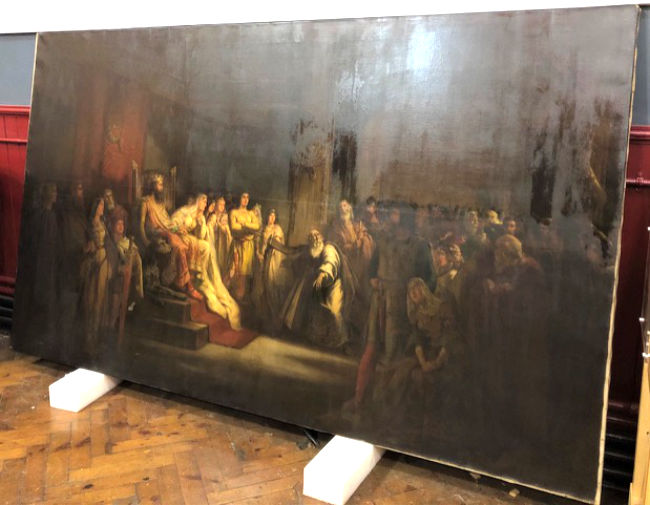
This painting was cleaned in 2019 by Corrie Tubman in the first phase of a anticipated larger conservation project.
Significance
Tara’s Halls is a large, undated oil painting by William Magrath, which for many years hung high up in Crawford Art Gallery’s lecture theatre.
The painting’s subject is derived from Thomas Moore’s “The Harp That Once through Tara’s Halls” (1807), a popular ballad to which James Joyce also refers in Ulysses (1922). It is a meditation on national spirit (harp) and the loss of self-rule (kingship of Tara) in the aftermath of the Acts of Union (1800).

Tara’s Halls at the beginning of surface cleaning (centre)
Painted in the United States during Magrath’s later career, Tara’s Halls is notably one of the first purchases made through the Gibson Bequest Fund. Having been acquired for the Collection in 1920 from Mrs A. McSwiney, it is also a deeply political statement in the context of the Irish War of Independence (1919-21).
William Magrath (1838-1918) was a native of Cork and was educated at St. Stephen’s Hospital and the Blue Coat School, before enrolling at the Cork School of Art in 1856. ‘His subsequent career,’ as John Gilbert observed, ‘was remarkable for hard knocks and unassisted hard work.’ He led a peripatetic life, stowing away on vessel to New York where he found work as a sign writer. He attracted public attention for his portrait of General “Stonewall” Jackson (1824-1863) and later became involved with the Theosophists following a meeting with the Russian mystic, Madame Blavatsky (1831-1891). He later travelled in Ireland, Belgium, The Netherlands, and Italy, before settling in London, where he died on 12 February 1918.
Assessment
To make it ready for exhibition, Tara’s Halls was taken down from its location in Crawford Art Gallery’s lecture theatre with the use of scaffolding. Over several days in April 2019, conservator Corrie Tubman assessed and treated this historic work.

Through her investigation, Magrath’s technique of applying paint in a flat manner, sometimes very thinly, became apparent. Some small repairs from previous conservation work were also noted. More significantly, however, was a darkened and yellowed varnish that had been unevenly applied across the painting's surface and obscured much of its detail.
The canvas was discovered to be slack with some minor stretcher bar marks. Saturation levels were very poor due to the degraded natural resin varnish. It was also noted that the canvas may have been repositioned, either by the artist or others, at some point in its history as the edges of the painted composition do not align with the first turn-over edges.
The wooden frame, ornamented with fruit and leaf mouldings, was found to be dusty, structurally weak, and prone to torque.

Verso (reverse) of the canvas on 6-bay wooden stretcher with one horizontal, two vertical cross bars, and fourteen wooden keys.
Treatment
Loose surface dust was first removed with a soft brush and vacuum. This was followed by removal of more ingrained dirt using a wet/dry method and cotton swab.

Once the very thick dark-brown dirt layer – suggestive of nicotine! – was removed, some of the painting’s long-hidden details finally began to reveal themselves, including numerous background figures and an architectural space with medieval décor, which all serve to enrich Magrath’s original scene.

The ornamental frame was also cleaned during this process but will require further repair and stabilisation in the future.
Display
Since this conservation work was undertaken, Tara’s Halls has been exhibited in The Gibson Bequest 1919-2019: Selecting, Collecting & Philanthropy (3 May 2019 – 19 January 2020).
In 2022, the painting was displayed for two months at Áras an Uachtaráin, Dublin.

CAG.0311 William Magrath, Tara’s Halls, undated, oil on canvas, 160.5 x 275 cm. Purchased, Mrs A. McSwiney, 1920 (Gibson Bequest Fund). Photo: Jed Niezgoda.
Text adapted from Condition Report (2019) by Corrie Tubman.
Emmett Place, Cork, Ireland
T12 TNE6
Tel: 021 480 5042
info@crawfordartgallery.ie
Opening Hours
N.B. Last entry is 15 minutes before closing
Monday–Saturday 10.00am–5.00pm*
Thursday until 8.00pm
Sundays and Bank Holidays
11.00 am–4.00pm
© 2024 www.crawfordartgallery.ie